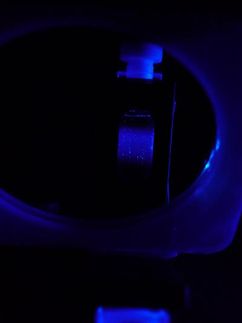Threading the Molecular Needle: ASU Biodesign Researcher to Explore Revolutionary Gene Sequencing
National Institutes of Health awarded a $550,000 three-year grant
Advertisement
The ability of molecular biologists to sequence the human genetic code promises to usher in a new era of genetic medicine, but that doesn't mean current science can accurately read your personal genetic code. The sequencing of the DNA comprising the code is still far too slow, costly and inaccurate to allow the kind of accurate sequencing of specific tissues that is necessary to understand many of particular genetic problems of individual patients.
A radical new method of DNA sequencing currently being explored by Stuart Lindsay, Director of the Center for Single Molecule Biophysics in the Biodesign Institute at Arizona State University and Professor of Physics at ASU, could make the long-dreamt-of era of true genetic medicine possible with extremely rapid, accurate and low cost sequencing of single DNA molecules. However, a number of significant technical hurdles still need to be overcome before the idea can be considered a usable technology.
With the goal of overcoming these technical challenges, the National Human Genome Research Institute (NHGRI) of the National Institutes of Health has awarded a $550,000 three-year grant to Lindsay to further develop a nanotechnology project for rapid genetic profiling. The award is just one of seven given this year in NHGRI's "Revolutionary Genome Sequencing Technologies" grant program, which the Institute says is aimed at "the development of breakthrough technologies that will enable a human-sized genome to be sequenced for $1,000 or less."
As a scientist, however, Lindsay is careful in not claiming a breakthrough yet. "There is still a fair amount of harsh reality to deal with," he said. "As we work harder on the project, we haven't yet encountered any fundamental problems that say this is impossible but we have encountered lots of challenges that still need to be solved. But this is what scientific research is about. We are making solid progress and every time a new problem has come up, we have found a way around it. This grant is a wonderful opportunity to continue the work."
Lindsay's new sequencing technology involves using Atomic Force Microscopy (AFM), which is customarily used to analyze the surface structure of materials at molecular resolution with the ultra-small tip of a sensitive probe, in combination with naturally occurring ring-shaped sugar molecules called cyclodextrins. Lindsay believes that the ring molecules, when paired with the AFM probe tip, can effectively be used as sensors to "read" the sequence of amino acid code (DNA "bases") in the human genome that comprises many millions of bases.
"Cyclodextrins are Mother Nature's little molecular rings," explained Lindsay. "They are just big enough to slide a strand of DNA through. Conveniently, Mother Nature also makes them with neat little reactive groups on the side, so you do chemistry with them."
Through the reactive groups on the side of the rings, Lindsay's technology proposes to attach the ring to the sensitive AFM tip, which would thread an anchored DNA molecule into the ring and pull it through, recording the subtle differences in the "bumps" resulting from the friction of the different DNA bases with the ring. The resulting data could thus be translated into the precise sequence of the DNA molecule.
To thread the DNA through the cyclodextrin molecular ring, the cyclodextrin molecules are first assembled around a long, straight molecule, like beads on a wire. The "wire" molecule is then attached to a surface at one end, and to the end of a DNA molecule at the other by chemical bonds. The AFM tip bonds to the "bead" and by its movement rapidly pulls first the "wire" and then the DNA molecule through the ring.
If Lindsay's proposed sequencing method can be made towork, it would be remarkably faster and more accurate than current sequencing technology.
"With increases in technology, there is no reason that you couldn't read bases in microseconds, in which case you could get the time for sequencing the whole human genome down to hours," he said.
The first sequencing of the human genome, completed in 2002, took two teams 11 years to do and cost $1 billion. Lindsay's method could make the same genome sequencing feat possible at less that $1,000.
"The other advantage is that this method can be used for a single molecule," Lindsay notes. "You could take a piece of DNA out of a cancer cell and get its coding sequence, and take the DNA out of an adjacent normal cell and ask what its sequence is for comparison.
"You can do this without modifying the DNA. Current sequencing techniques, which are very slow, require you to take the DNA and copy it through the polymerase chain reaction, which is error prone. Subtle, single base differences that may have to do with the disease, can easily get lost."
Although the concept sounds relatively straightforward, making things work in the nanospace of individual molecules is very difficult and there are numerous technical hurdles that Lindsay and his team still have to get over.
Despite the challenges, Lindsay is encouraged that NHGRI has selected his proposal for funding along with a very small number of other competing ideas in an area that is critical to the future of bioscience. The award is one 19 grants the institute announced, and one of two given to ASU researchers in a round of NIH funding totaling $38 million.































































